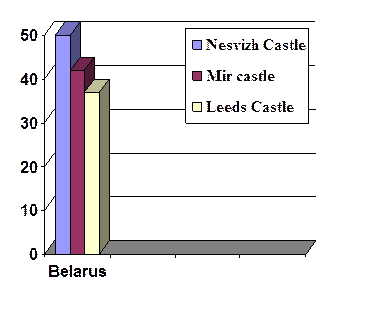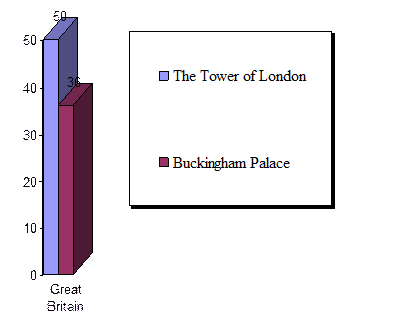
A COMPARATIVE CHARACTERISTIC OF THE CASTLE BUILDINGS OF BELARUS AND
GREAT BRITAIN
CONTENTS
INTRODUCTION…………………………………………………………...3
1. CASTLE BUILDINGS IN BELARUS AND GREAT BRITAIN…….….4
2. COMMON AND DISTINCTIVE FEATURES OF CASTLE BUILDINGS…….………………………………………………………….. 6
2.1. Defensive castle………..………………………………………………..6
2.2. Palace..…………………………………………………………………..6
2.3. Castle-prison...…………………………………………………………..7
CONCLUSION.…………………………………………………………….11
BIBLIOGRAPHY…………………………………………………………..12
APPENDIX А
APPENDIX B
APPENDIX C
INTRODUCTION
The architectural creations reflect
historical and cultural potential of the society. If we want to know and
understand better the culture of the country, we need to know and understand
its architecture. The study of architectural heritage is always important.
The theme of our research work was
chosen to promote castle architecture of Belarus and Great Britain and attract
students to studying castle buildings.
Urgency: the preservation of the historical heritage of Belarus and Great Britain
Novelty: an attempt to compare castle buildings of the countries with different history and culture
Object of research: castle buildings of Belarus and Great Britain
Subject of research: common and distinctive features of castle buildings
Purpose of the study: to identify common and distinctive features castle buildings in Belarus and Great Britain
The purpose of the work determined the following tasks:
1. to study literature on the research topic;
2. to search and accumulate information about the castle buildings in Belarus and Great Britain;
3. to make up a list of the castle buildings;
4. to compare castle buildings of Belarus and Great Britain on various characteristics;
5. to single out common and distinctive features of the castle buildings
To achieve the purpose and the tasks of the work we use the methods of research: classification and systematization, analysis and generalization.
Hypothesis: There are common and distinctive features between the castle buildings of Belarus and Great Britain. In order to identify them, we should compare castles according to various criteria.
1. CASTLE BUILDINGS OF BELARUS A ND GREAT BRITAIN
The development of Belarusian culture took place in difficult historical conditions: from the XIV century the territory of Belarus was included into the Grand Duchy of Lithuania, in the sixteenth century in Rech Pospolitaya. Different areas of Belarusian architecture associated with the Russian, Eastern European and Western medieval art.
Since the second half of the XV century the in castle architecture a new trend appeared – the usage of own interpretation of the achievements of European architecture along with the development of local building traditions.
Palace and castle complexes appeared in Belarus in XVI – XVII centuries. Elements of Renaissance, Baroque and Russian architecture penetrated in architecture.
The evolution of British castle architecture was closely associated with the historical processes and events that took place in Britain. Its heyday the castle architecture reached in the Middle Ages, embracing and developing the best scientific achievements of the fortification thoughts of many generations of different peoples inhabiting the British Isles. It contributed to the preservation, development and dissemination of scientific thought in general.
In the early Middle Ages the first builders of castles were Germanic tribes of Angles and Saxons. A huge number of monuments were left by Romans. The true heyday of castle building in the British Isles began after the Norman conquest of the eleventh century. In XII-XIII centuries the crusaders brought new developments from the Holy Land that became the cornerstones of the British castle architecture.
At the end of the XV century in the country there was a peace after the War of the Roses and lords did not need fortresses. So began the era of the palace complexes.
Although the original meaning of existence castles was lost they continue to play an active role in the life of Belarus and Great Britain. Castles reflect the rich history of our countries. That is why castle buildings are of great interest today.
At the beginning of the research we conducted a questioning of 50 students from the 8th, 10th and 11th classes. We asked two questions: "What castle buildings in Belarus and great Britain do you know?" and "Would you like to get more information about castle buildings?" (Appendix A). Among Belarusian castles students named only Niesvizh, Mir and Leeds castles. Among the castles of Great Britain were the Tower of London and Buckingham Palace (Appendix B).
During the study we examined the most famous castle buildings in Belarus and Great Britain. We took fourteen castles. In Belarus they are Nesvizh Castle, Sapieha Palace complex, Pishchalausky Castle, Golshany castle, Mir castle, Kossov castle and Lyubcha Castle. We studied the following British castles: Sterling Castle, the Tower of London, Leeds Castle, Inverary Castle, Alnwick Castle, Castle Harlech and Ebbotsford Castle. While studying, the student divided castles into groups depending on their functions. They are a defensive castle, a palace and a castle-prison. Using the dictionaries (Oxford Dictionary, Cambridge Dictionary, the Longman Dictionary of Contemporary English) we have made up an explanatory dictionary of these terms (Appendix C).
2. COMMON AND DISTINCTIVE FEATURES OF CASTLE BUILDINGS
2.1. Defensive castle
Defensive castle is a large building built in the past for protection from attacks.
As an example of a defensive castle we have chosen Nesvizh Castle and Leeds Castle.
Table 1
|
The name of the building |
Common features |
Distinctive features |
|
|
Functions |
|
|
Nesvizh castle |
1. Nesvizh Castle and Leeds Castle were built to protect against attacks |
|
|
Leeds Castle |
|
|
|
|
Historical period |
|
|
Nesvizh castle |
|
1. the construction of Nesvizh Castle began in spring of 1853 and took seven years. |
|
Leeds Castle |
|
1. the construction of Leeds Castle began in 1119 and lasted for two centuries. |
|
|
Architecture |
|
|
Nesvizh castle |
1. both castles were built on the site of the old wooden buildings; 2. both castles stand on the river; 3. both castles have a defensive wall, a bridge and a moat filled with water |
1. the castle is on the right bank of the river Usha |
|
Leeds Castle |
1. the castle stands on the two islands in the river Len |
|
|
|
The use of the castle during its history |
|
|
Nesvizh castle |
1. over the time Nesvizh Castle and Leeds Castle have become the palaces with large park complexes |
|
|
Leeds Castle |
|
|
|
|
Nowadays condition |
|
|
Nesvizh castle |
1. both castles are included into the world heritage list of UNESCO |
|
|
Leeds Castle |
|
|
From this table we can see that both castles were built for protection. They are similar in their structure and both have become Palace-Park complexes. The main difference between these buildings is their age and the duration of construction.
2.2. Castle
Palace is a large house that is the official home of a person of high social rank
Palace was considered on the example of Sapieha Palace Complex and Abbotsford Castle.
Table 2
|
The name of the building |
Common features |
Distinctive features |
|
|
Functions |
|
|
Sapieha Palace Complex |
1. both palaces are built as residents for noble people
|
|
|
Ebbotsford Castle |
|
|
|
|
Historical period |
|
|
Sapieha Palace Complex |
|
1. the palace was built in 1602 |
|
Ebbotsford Castle |
|
1. the construction if the palace begat in 1812 and lasted for 12 years |
|
|
Architecture |
|
|
Sapieha Palace Complex |
1. both palaces has inner courtyards around which the buildings were erected; 2. the facades of the palaces were decorated with sculptures; 3. in both palaces there were huge libraries and collections of ancient things;
4. the parks and forests were located around the palaces. |
1. Sapieha Palace Complex consisted of symmetrical buildings which are located around an inner courtyard; 2. in Sapieha Palace Complex there was a theatre, arena and the zoo |
|
Ebbotsford Castle |
1. Abbotsford Castle consisted of four rooms, to which new rooms were gradually added for twelve years; 2. the Abbotsford Castle is located on the bank of the river; |
|
|
|
The use of the castle during its history |
|
|
Sapieha Palace Complex |
|
1. during its history Sapieha Palace Complex was used not only for living but also as a cloth factory
|
|
Ebbotsford Castle |
1. Abbotsford Castle was used only for its intended purpose |
|
|
|
Nowadays condition |
|
|
Sapieha Palace Complex |
|
1. Today Sapieha Palace complex is in a dilapidated condition, and the Palace |
|
Ebbotsford Castle |
1. Abbotsford Castle remains practically untouched |
|
From this table it is evident that the Palace complexes are similar in their functions and location of the buildings. The differences are in their age, in their use during the existence as well as their present state.
2.3. Castle-prison
Castle-prison is a large building where criminals live as a punishment.
As castle-prison we have chosen Pishchalausky Castle and the Tower of London.
Table 3
|
The name of the building |
Common features |
Distinctive features |
|
|
Functions |
|
|
Pishchalausky Castle |
1. both castles were built for holding persons in detention and execution
|
1. in Pischalausky Castle political and cultural figures served for punishment; 2. executions were carried out directly in Pischalauski Castle |
|
The Tower of London |
1. the Tower was intended for high rank people and members of their families; 2. in the Tower only seven people were executed, and the rest of the executions took place on the hill, near the prison |
|
|
|
Historical period |
|
|
Pishchalausky Castle |
|
1. Pishchalovsky Castle was build in |
|
The Tower of London |
|
1. the construction of White Tower was finished in 1110. The rest buildings were finished in 1377 |
|
|
Architecture |
|
|
Pishchalausky Castle |
1. Pishchalausky Castle and the Tower of London have a rectangular shape with four towers at the corners ; 2. both castles are enclosed by high walls; |
1. the castle was built in the Belarusian Gothic style; 2. the castle is situated on the hill |
|
The Tower of London |
1. the castle was built in the Pseudoroman style; 2. the Tower is situated on the river Thames |
|
|
|
The use of the castle during its history |
|
|
Pishchalausky Castle |
|
1. the castle was used only as a prison |
|
The Tower of London |
1. the castle was not only a prison but a Royal residence, a mint and even a zoo |
|
|
|
Nowadays condition |
|
|
Pishchalausky Castle |
|
1. today Pishchalausky Сastle is Detention centre No. 1 |
|
The Tower of London |
1. today the Tower is a museum |
|
The table shows that the prisons are similar in their purpose and architectural form. The difference is that they were built in different periods. They were also differently used in their history and today they have different functions.
CONCLUSION
The aim of the work was to identify common and distinctive features of castle buildings in Belarus and Great Britain. During the work we have carried out the analysis of literary sources, visual inspection of objects of the study with systematization and generalization of the information.
Six castle buildings were compared between each other on such criteria as purpose, historical period, the architecture, the use of the castle during its history and nowadays condition.
In general we can say that castle buildings that we have compared are similar in their functions and architecture. The main difference is their age and the length of construction.
In
the course of the research work the following tasks were accomplished:
► to study literature on the research topic;
► to search and accumulate information about the castle buildings in Belarus and Great Britain;
► to make up a list of the castle buildings;
► to compare castle buildings of Belarus and Great Britain on various characteristics;
► to single out common and distinctive features of the castle buildings
We came to the conclusions:
1. We have studied the literature on the research topic and made a list of the castles in Belarus and Great Britain with their short description;
2. We have compared castle buildings on the following characteristics: purpose, historical period, the architecture, the use of the castle during its history, nowadays condition.
3. We have singled out differences and similarities between the castle buildings.
4. We have made up an explanatory dictionary with the term of castle buildings.
This is the value of the work. The materials of the study can be used at the lessons of English during the studying such topics as “Belarus” and “The United Kingdom of Great Britain and Northern Ireland”.
1. Лисицина А.С.Знаменитые замки Европы – 2-е изд. / А.С.Лисицына. – М. : Эксмо, 2013
2. Ткачев М.А. Замки Беларуси / М.А.Ткачев. – Мн. : Беларусь, 2002
3. Cambridge Dictionaries
http://dictionary.cambridge.org/
4. Ebbotsfort Palace
http://www.scottsabbotsford.com/
5. Leeds Castle
http://www.britainexpress.com/
6. Oxford Dictionaries
http://www.oxforddictionaries.com/
7. Pishchalausky Castle
http://palac.by/
8. Sapieha Palace Complex
http://probelarus.by/
9. The Longman Dictionary of Contemporary English
http://www.ldoceonline.com/
APPENDIX A
What castle buildings of Belarus and Great Britain do you know?
Diagram 1
Diagram 2 

Do you want to know more information about castle buildings?
Diagram 3


APPENDIX B
|
Fig. 1
Nesvizh Castle, town Nesvizh, Belarus
The construction of Nesvizh Castle began in the spring of 1853 by order of Mikolaj Radziwill nicknamed Sirotka. The castle was built on the site of the old wooden castle on the right Bank of the river Usha. Construction took seven years. A mighty fortress was surrounded by a moat. For a century Nesvizh Castle has withstood many attacks. In 1706 it was stormed by the army of Charles XII. The Swedes captured the castle and partially destroyed it. By the middle of XVIIIth century the castle was rebuilt. In the period from the second half of the eighteenth century to the mid-nineteenth century, the castle was captured by Russian troops. After that the castle returned into the possession of the Radziwills. The castle was enlarged and a Palace and Park complex was built, which included the Castle Park, Old Park, New Park, English Park and Japanese garden. In 1939 he the Soviet power came and the Radziwill family war forced to leave the castle. After the collapse of the Soviet Union castle complex came under the trusteeship of the Ministry of Culture of the Republic of Belarus.
|
Fig. 2
Leeds Castle, county Kent, England
Leeds castle is named in honor of Liege Leda, who was the head of the government of the king Elbert IV. The first wooden fortress was built in 875 year on the river Len. In 1119 the grandson of Wilhelm II started building the castle as a stone fortification on two rocky Islands in the river Len. The construction works have lasted for two centuries. In 1278, the new owner of the castle was Elinora Castilian. Since that time Leeds Castle became the Royal property. The main purpose was the strengthening of walls and creation of comfortable conditions for life of the Queen. The walls were fortified and a bridge was built that linked a large island with a small. After the death of Queen Elinor, the castle passed from Queen to Queen. The main changes in the castle happened at the beginning of the XVI century by order of Henry VIII. Leeds was transformed into a Palace. During the wars, the castle remained intact, the main damage Leeds Castle suffered in 1660, when it passed to the government. In 1825 the owner of the castle was Lady Bailey. After her death in 1974, the castle and its historical Park became the property of the national trust, founded by Lady Bailey. |
|
Fig. 3
Sapieha Palace complex, urban settlement Ruzhany, Belarus
In 1598 the Chancellor Lev Sapieha bought the estate of Ruzhany. He built a Palace there in 1602. In the Palace Sapieha placed the archaeological Museum and a huge library. The castle was destroyed in 1698 by the troops of the confederates, but the rich owners of Ruzhany restored the Palace in several decades. The Palace complex was formed from symmetrical buildings around a closed courtyard with park, garden and greenhouse. The facades of buildings were decorated with garlands, pilasters and sculptures. There were also a theatre, arena and art gallery in the Palace. But in 1786, after the allotment of Rech Paspalitaya Alexander Sapieha leased the Palace to Jewish businessman under the cloth factory. In 1914 there was a fire in Ruzhany Castle, and in 1944 it was destroyed during the hostilities. Since 2008 in the Palace Complex has been restoring. But now the Palace is in a tumbledown condition. |
Fig. 4
Palace Ebbotsford, Scotland
In 1811 Sir Walter Scott purchased 100 acres of land on the banks of the river Tweed. In this place he began to build a mansion. Scott called it Abbotsford that was the name of the ford across the river Tweed. The ford was used by the monks to cross the river. Preparation for construction began in 1812. The construction of the mansion went gradually room by room. The total duration of the work took 12 years. The mansion was built by the project of Walter Scott. It was a kind of Museum of Scottish past. Stained glass windows which depicted the Kings of Scotland were copied from the ceiling of Sterling castle, the fountain was built in the form of the Edinburgh cross. There were copies of gargoyles from Melrose Abbey. The Palace housed a library, a collection of weapons, furniture and antiques. The construction was completed in 1824. From 1826 till the death Walter Scott had lived and worked in Abbotsford. |
|
Fig. 5
Pishchalausky Castle, city Minsk, Belarus
Pishchalausky Castle was built in Minsk in 1825 by the request of Minsk Governor to build a new stone prison. The castle was built on the Raman hill. Now it is the center of Minsk. The castle was built by landlord Rudolf Pishchalo and was built in Belarusian Gothic style. It is a rectangular three-storied building with four round towers at the corners. The prison is unique not only for its architecture but also for its prisoners. Belarusian writers, cultural and political figures served out punishment there. The first prisoners were the Polish rebels in 1831. Then the prisoners were treated humanely by providing a separate camera and hot meal. In 1960, the castle received its modern name of Detention Facility No 1. Today it is one of the oldest buildings in Minsk, the only place in Europe where the death penalty is carried out.
|
Fig. 6
The Tower of London, city London, England
For the security of London during the coronation William ordered to build a fortress around the city. In 1110 the construction of White tower was finished. It is protected by walls from the Northern, Western and Southern sides. All the buildings in Tower were finished in 1377. The first person was imprisoned in Tower in 1100. The Tower-prison intended for people of noble origin. These were Kings of Scotland and France, aristocrats and priests. Prisoners were kept in separate rooms. Only five women and two men were beheaded in the Tower of London. Mostly executions took place on Tower hill, near the castle. More than 1,500 people are buried in the cellars of the Tower. The last beheading occurred in 1747. However, the history of the Tower as a prison was not over. During the First World War eleven German spies were imprisoned in the castle. The last death penalty was held in 1947. This was Joseph Jacobs, who was accused of espionage.
|
APPENDIX C
|
|
Oxford Dictionary |
Cambridge Dictionary |
The Longman Dictionary of Contemporary English |
|
Defensive castle |
A large building, typically of the medieval period, fortified against attack with thick walls, battlements, towers, and often a moat |
A large strong building, built in the past by a ruler or important person to protect the people inside from attack
|
a very large strong building, built in the past as a safe place that could be easily defended against attack |
|
Palace |
A large and impressive building forming the official residence of a ruler, pope, archbishop |
A large house that is the official home of a king, queen, or other person of high social rank |
The official home of a person of very high rank, especially a king or queen - often used in names
|
|
Castle-prison |
A building to which people are legally committed as a punishment for a crime or while awaiting trial |
A building where criminals are forced to live as a punishment |
A building where people are kept as a punishment for a crime, or while they are waiting to go to court for their trial |
Скачано с www.znanio.ru
Материалы на данной страницы взяты из открытых источников либо размещены пользователем в соответствии с договором-офертой сайта. Вы можете сообщить о нарушении.